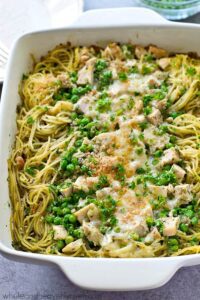The Ultimate Comfort Food Homemade Baked Mac and Cheese is a delicious recipe that combines amazing flavors and textures.
This ultimate baked macaroni and cheese represents the pinnacle of comfort food perfection, featuring a luxuriously creamy cheese sauce enveloping tender pasta, all topped with a crispy, buttery breadcrumb crust. What sets this version apart is its sophisticated cheese blend – sharp cheddar provides tanginess, Gruyère adds nutty complexity, and the technique ensures a smooth, stable sauce that doesn’t separate when baked. The result is a dish that delivers both childhood nostalgia and grown-up refinement in every bite.
The magic of this mac and cheese lies in its textural contrast and flavor depth. The sauce achieves perfect viscosity – thick enough to coat each piece of pasta but fluid enough to create a creamy experience. The breadcrumb topping provides necessary crunch that balances the richness, while the hint of cayenne adds subtle warmth that enhances rather than overwhelms the cheese flavor. This is comfort food elevated to company-worthy status without losing its essential soul-satisfying character.
Historical Context and Cultural Evolution
Macaroni and cheese has a surprisingly international history that belies its status as an American comfort food staple. The combination of pasta and cheese dates back to 14th century Italy, where early cookbooks documented primitive versions. Thomas Jefferson encountered the dish in France and brought it to America, where it became particularly associated with Southern cooking.
The baked version with breadcrumb topping evolved in the early 20th century as home ovens became more common. During the Great Depression, it gained popularity as an economical yet nutritious meal that could stretch precious ingredients. The boxed version emerged in the 1930s, making it accessible to millions. Our from-scratch version honors this history while employing techniques that maximize flavor and texture, representing how humble ingredients can achieve greatness through proper preparation.
Ingredient Selection Guide
Cheese: Use a combination of cheeses for complexity. Sharp cheddar provides flavor foundation, while Gruyère or Comté add nutty notes. For extra sharpness, add Parmesan or Asiago. Always grate your own cheese – pre-shredded contains anti-caking agents that can affect sauce texture.
Pasta: Elbow macaroni is traditional, but cavatappi, shells, or rigatoni work well. Choose shapes with nooks that trap sauce. Cook pasta very al dente (1-2 minutes less than package directions) as it will continue cooking in the oven and sauce.

Dairy: Whole milk provides richest sauce. For extra creaminess, substitute 1 cup milk with heavy cream. Warm the milk before adding to roux for smoother incorporation and faster thickening. European-style butter adds superior flavor.
Breadcrumbs: Panko breadcrumbs create exceptionally crispy topping. For homemade, pulse stale artisan bread in food processor. Season breadcrumbs with garlic powder, onion powder, or dried herbs for extra flavor dimension.
The Science of Cheese Sauce Stability
Creating a stable cheese sauce that doesn’t separate when baked involves understanding emulsion science. The roux (butter and flour cooked together) acts as an emulsifier, with starch molecules surrounding fat droplets to keep them suspended. Heating causes starch granules to swell and absorb liquid, thickening the sauce through gelatinization.
Cheese contains both fat and protein, along with natural emulsifying salts. Adding cheese to excessively hot sauce can cause proteins to tighten and squeeze out fat, resulting in grainy texture. Adding cheese off heat and stirring gently preserves the emulsion. Acidic ingredients like mustard help stabilize the emulsion by affecting protein behavior.
Step-by-Step Technique Mastery
Roux Preparation: Cook butter and flour for at least 1 minute to eliminate raw flour taste, but don’t let it darken beyond pale gold for white sauce. Whisk constantly to prevent lumps and ensure even cooking. The roux should have a nutty aroma when ready.
Milk Incorporation: Add milk gradually, whisking constantly to prevent lumps. Cold milk added too quickly can cause lumps, while warm milk incorporates more smoothly. Cook until sauce coats the back of a spoon and leaves a clear path when you run your finger through it.
Cheese Addition: Remove sauce from heat before adding cheese. Stir in gradually until melted but not overmixed. Overheating or vigorous stirring can break the emulsion, causing oil separation. If sauce breaks, blend with immersion blender to re-emulsify.
Baking Technique: For optimal texture, bake until bubbly around edges and topping is golden brown. Let rest before serving to allow sauce to set slightly for cleaner portions. The carryover heat will continue cooking the pasta and melding flavors.
Customization and Creative Variations
This recipe serves as a perfect canvas for creativity: Add cooked bacon or pancetta for smokiness; Incorporate vegetables like roasted broccoli, caramelized onions, or sautéed mushrooms; Mix in cooked lobster or crab for luxurious version; Use different cheese combinations like Gouda and ham for Dutch influence; Add spices like smoked paprika, nutmeg, or truffle oil for sophistication.
For crispy edges, bake in individual ramekins or cast iron skillets. For extra creaminess, layer with additional cheese between pasta layers. For sophisticated twist, top with fried shallots, onion strings, or crispy prosciutto instead of breadcrumbs.
Professional Chef Secrets
For ultra-smooth sauce, strain through fine-mesh sieve before combining with pasta. For enhanced flavor, infuse milk with bay leaf, onion, and peppercorns before making sauce, then strain. For exceptional richness, replace 1/4 cup butter with rendered bacon fat or duck fat in the roux.
For make-ahead option, prepare completely but don’t bake. Refrigerate overnight and add 10-15 minutes to baking time. For freezer-friendly version, freeze unbaked and bake from frozen, covering with foil for first 30 minutes to prevent over-browning.
Serving and Presentation Techniques
Serve in colorful ceramic baking dish for rustic family-style presentation. Garnish with fresh herbs like chives, parsley, or thyme for color contrast. Offer hot sauce, Worcestershire sauce, or truffle oil on the side for custom seasoning.
Pair with crisp green salad with vinaigrette to cut through the richness. For wine pairing, choose crisp white like Sauvignon Blanc or light red like Gamay. For non-alcoholic option, sparkling cider or lemonade complements the richness beautifully.
Storage and Reheating Guidelines
Leftovers keep refrigerated for 4 days. Reheat in oven at 350°F for best texture restoration. Microwave reheating can make the sauce oily – if using microwave, reheat at 50% power and stir frequently to redistribute fats.
To freeze, portion completely cooled mac and cheese into airtight containers. Freeze for up to 3 months. Thaw in refrigerator overnight before reheating. Add a splash of milk when reheating to restore creaminess lost during freezing.
Final Thoughts
As you break through the golden, crispy topping into the creamy, cheesy interior, appreciate how this humble dish has comforted generations and continues to bring people together around the table. May it become a cherished part of your family’s culinary tradition, creating memories with every delicious bite.

The Ultimate Comfort Food Homemade Baked Mac and Cheese
Ingredients
Method
- Preheat oven to 375°F
- Cook pasta al dente in salted boiling water
- Drain and set aside
- Melt butter in large saucepan over medium heat
- Whisk in flour and cook for 1 minute until golden
- Gradually whisk in milk until smooth
- Cook until thickened, stirring constantly
- Remove from heat and stir in cheeses until melted
- Season with mustard powder, cayenne, salt and pepper
- Add drained pasta to cheese sauce, stir to coat
- Transfer to greased 9×13 baking dish
- Mix topping ingredients and sprinkle over pasta
- Bake for 25-30 minutes until bubbly and golden
- Let rest for 10 minutes before serving
- Garnish with additional parsley if desired



